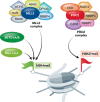Chromatin remodeling and bivalent histone modifications in embryonic stem cells
- PMID: 26553936
- PMCID: PMC4693513
- DOI: 10.15252/embr.201541011
Chromatin remodeling and bivalent histone modifications in embryonic stem cells
Abstract
Pluripotent embryonic stem cells (ESCs) are characterized by distinct epigenetic features including a relative enrichment of histone modifications related to active chromatin. Among these is tri-methylation of lysine 4 on histone H3 (H3K4me3). Several thousands of the H3K4me3-enriched promoters in pluripotent cells also contain a repressive histone mark, namely H3K27me3, a situation referred to as "bivalency". While bivalent promoters are not unique to pluripotent cells, they are relatively enriched in these cell types, largely marking developmental and lineage-specific genes which are silent but poised for immediate action. The H3K4me3 and H3K27me3 modifications are catalyzed by lysine methyltransferases which are usually found within, although not entirely limited to, the Trithorax group (TrxG) and Polycomb group (PcG) protein complexes, respectively, but these do not provide selective bivalent specificity. Recent studies highlight the family of ATP-dependent chromatin remodeling proteins as regulators of bivalent domains. Here, we discuss bivalency in general, describe the machineries that catalyze bivalent chromatin domains, and portray the emerging connection between bivalency and the action of different families of chromatin remodelers, namely INO80, esBAF, and NuRD, in pluripotent cells. We posit that chromatin remodeling proteins may enable "bivalent specificity", often selectively acting on, or selectively depleted from, bivalent domains.
Keywords: chromatin; chromatin remodeling; embryonic stem cells; epigenetics; histone modifications.
© 2015 The Authors.
Figures




References
-
- Kouzarides T (2007) Chromatin modifications and their function. Cell 128: 693–705 - PubMed
-
- Tessarz P, Kouzarides T (2014) Histone core modifications regulating nucleosome structure and dynamics. Nat Rev Mol Cell Biol 15: 703–708 - PubMed
-
- Azuara V, Perry P, Sauer S, Spivakov M, Jorgensen HF, John RM, Gouti M, Casanova M, Warnes G, Merkenschlager M et al (2006) Chromatin signatures of pluripotent cell lines. Nat Cell Biol 8: 532–538 - PubMed
Publication types
MeSH terms
Substances
Grants and funding
LinkOut - more resources
Full Text Sources
Other Literature Sources

